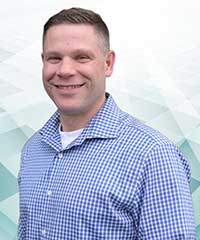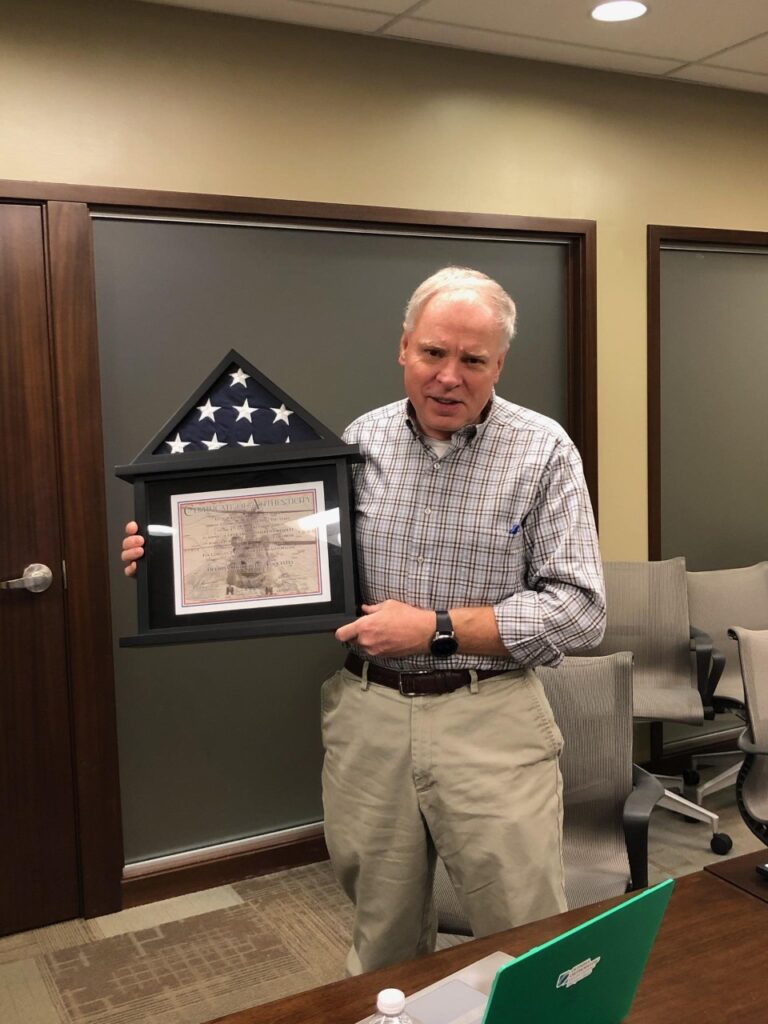Steve Johns is a Physician Assistant at Olympia Orthopaedic Associates who works with Dr. Brodie Wood. As a physician assistant, Steve has many roles, including 1) seeing patients in clinic; 2) first-assisting with Dr. Wood’s surgeries; and 3) seeing hospitalized patients post-operatively. He is also an Ironman athlete and serves in the Army Reserves on the aviation medical team. After his most recent deployment to Iraq in 2019, he brought back a special flag for presentation to OOA in gratitude for their ongoing support.
Call Us Today! 360.570.3460

How has your experience in the army has shaped your medical career?
I’ve been in the military for 25 years. I joined as soon as I graduated high school and I was in active duty for four years as a combat medic. After that, I joined the Army Reserves. After going back to school to become a scrub technician, I’ve travelled all over with the army as a scrub tech..
In the army reserves, there is a minimum requirement of one weekend per month and two weeks per year of service. For some of those two-week periods, I’ve gone to Alaska, Italy, and elsewhere to work in the medical field, whether it was backfilling in a hospital or doing medical processing for people who were deploying.
Tell us how you became a Physician Assistant (PA).
I worked as a scrub technician in an operating room on a cardiac team for about nine years. Two of the PAs on that team encouraged me strongly to go back to school. Because I worked full-time and was in the army, it took about four years of night school and summer school to get all of my prerequisites classes done.
When I started the PA program in 2010, it was a two-year course. Now it’s a 28-month course because they’ve added an additional four months. I honestly think it’s one of the best jobs in medicine. The education portion is pretty daunting but I think the job satisfaction afterwards is huge. Without a doubt, I am always pushing anyone who is remotely interested in the job to shadow a PA and figure out what their plan could be to get into a program. I feel very lucky to have this job.
What is the key to a successful working relationship with Dr. Wood?
Dr. Wood has a very busy practice and so I’ve become kind of an extension of him. Along with Lex Barker PA-C, we are the extra sets of hands he needs to see patients and keep things moving more efficiently. We have a great deal of autonomy to care for his patients.
Also, continuity of care for patients is very important. So if I’m going to assist with a patient’s surgery, then 95% of the time I will see that patient both preoperatively and postoperatively. Then when I assist on their surgery, I can give them the intricate details of their surgery the next day when I round them. Being in the medical field for so long and working as a medic and a technician, I understand how to present technical medical information in layman’s terms. Patients often tell me that they feel I’m approachable and easy to connect with, which makes me really happy.
How did you start doing Ironman competitions?
I give all the credit to my wife. In 2009, she decided she wanted to do a triathlon on Fort Lewis and I did it with her. Being in the military, I’ve always run a lot and I had started cycling too, but I did not have any swimming background. I really enjoyed the triathlon experience so I continued doing them. In 2016, I completed my first Ironman: a 2.4-mile swim, followed by 112-mile bike ride, and then a 26.2 mile run afterwards. As of now, I’ve completed three Ironmans and I have two more scheduled in 2020.
My training means a lot of late nights and long weekends. It’s typically 1.5 hours per night during the week and it can be 6 hours each day on Saturdays and Sundays. I only work four days a week, which is a blessing, so I also have Mondays to do my long workouts.
Tell us about your most recent deployment.
I deployed in September 2019 and got back in January 2020. I was just north of Baghdad, Iraq at a base called Taji. In the military, I am a PA but I am also an aeromedical physician assistant, so I am able to provide specialized medical care to aircraft personnel. Anybody who is operating an aircraft has to be under a separate set of medical rules as far as allowable medications and whether or not they can operate an aircraft.
Typically, a normal flight crew has two pilots, a crew chief, a flight paramedic and, in the last few years, the military has added on an Emergency Critical Care Nurse (ECCN) that goes on the aircraft as well. We were short of ECCNs on this deployment, so three PAs filled that role in addition to our other duties. I was on-call for 48 hours at a time on the flight line in case of a medivac. I went on about four medivacs while I was there.
Why did you choose to do a flag presentation for OOA?
I think it’s very difficult for any employer when they have a military employee. It’s especially hard when that individual is a patient provider, as I am. The flag presentation was a way to show my respect for OOA. I really appreciated that they didn’t make me feel bad about having to serve and go. There was never any negativity. It was all support.
There’s a number of different ways to do a flag presentation. Some people carry a flag the whole time they’re deployed. For us, in aviation, it’s more typical to carry a flag on certain missions. At the completion of that mission, the flight personnel create a special certificate that shows which aircraft the flag was flown on, the location that it went to, and all the crew members’ names. It is one-of-a-kind because it’s one flag that was flown on one mission in Iraq on one day. The plan is to have it displayed in the Eastside Clinic entrance.

Did You Know?
Olympia Orthopaedic Associates has special programs between Madigan hospital on JBLM.
